Commemorative Plaques
The Ipswich Society
(see Links)
has installed a growing number of blue plaques in the town: their
version of
the English Heritage blue plaques seen in London. (By late 2012, with a
recession biting, E.H. announced that they would no longer be
researching, mounting and maintaining the London plaques, due to cuts
in funding – this seems to have changed again by 2014.) In 2024
Historic England started the new national
blue plaque scheme on behalf of the Department for Culture, Media &
Sport. What
started at the turn of the century continues to be an important and
relevant tribute to some of the most distinguished people who were born
in the town or subsequently lived there. The Society hopes that the
plaques
will make the streetscape and our history more interesting. Whereas the
EH plaques are of ceramic construction and usually require recessing
into the relevant building's fabric, the Society plaques are of
weatherproof man-made materials.
Blue Plaques
 2024 image
2024 image
ELIZABETH KNIPE COBBOLD (1766-1824)
On 1 December 2024 a blue plaque was
unveiled to celebrate the life and achievements of this most notable
member of the Ipswich brewing family. It is mounted on the wall of the
Stable Block in Holywells Park. Elizabeth
(Eliza) Knipe Cobbold (1764-1824) was a well-educated woman who
published poetry from an early age. Her first publication was called Six Narrative Poems (1787). Other
published poems were: The Mince Pye:
A Heroic epistle (1791) and Ode
to the Victory of Waterloo (1815). At the age of 27 she married
John Cobbold, of the well-known brewing family, and became mistress of
the Manor House and step-mother of his 14 children. They had a further
seven children. Cliff House (later The Brewery Tap, Cliff Quay) and
Holywells Mansion were also family homes. She was a champion of the
arts, history and science. She founded and supported many local
charities. Her elaborately paper-cut Valentine cards remain of local
historical interest and can be viewed at the Suffolk Record Office. A
fossil shell was named after her: Nucula
Cobboldiae. The author Clara Reeve is said to have been a
friend. Elizabeth supported Margaret Catchpole, her servant, through
Margaret's trials, imprisonment and transportation. A portrait of
Elizabeth is in Christchurch Mansion.
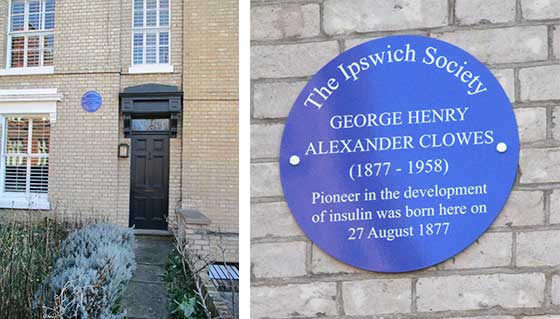 2024
image
2024
image
DR
GEORGE HENRY ALEXANDER CLOWES (1877-1958)
In March 2024 this plaque was unveiled to commemorate
Dr George Clowes (pronounced 'Clewes') who was born at 54 High Street.
After studying in England and on the continent, he emigrated to the
United States where he carried out research into cancer. He joined the
pharmaceutical company Eli Lilly, initially as a staff biochemist.
Within a year he was promoted to Head of Research & Development
where, in 1923, he oversaw the successful purification, standardisation
and mass production of the lifesaving drug insulin.
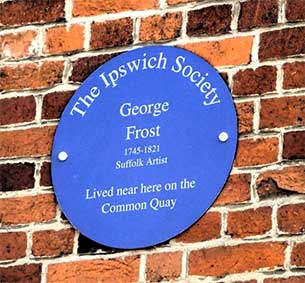 2023
image courtesy Tim Leggett
2023
image courtesy Tim Leggett
GEORGE FROST (1745-1821)
Unveiled on September 2023, this blue plaque is on the
side wall of the old Paul's Home Warehouse (later converted to offices
for Contship, then Ashton Legal),
opposite the east wall of the Custom House on Albion Quay. George Frost
(1754–1821) was an English landscape painter who lived in Ipswich, on
the Common Quay. He was born in Ousden in Suffolk the son of a builder
and brought up to his fathers business. However, he had a greater
interest in the world of art and gained employment in the town where he
worked until a few years before his death. Frost had a natural and
early love of drawing, he was self-taught as an artist. and his
obituary suggests admirable artistic ability which revealed: “the
character and genius of a master”.He was a great admirer and imitator
of Thomas Gainsborough and actually owned some paintings by the master
who is commemorated with a blue plaque in Foundation Street. Frost
copied his work as an act of dedication. He was also a close friend of
John Constable. (1776-1837).
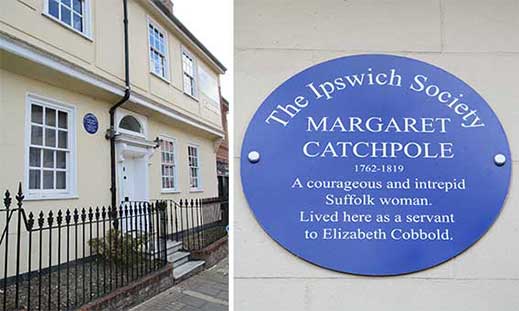 2022
images
2022
images
MARGARET CATCHPOLE (1762-1819)
6 St Margaret's Green ('The Manor House'). Margaret Catchpole is a
Suffolk folk heroine, subject of books and
plays and an opera. Although some aspects of her story have been
fictionalised, it is known that she lived in Nacton village where she
had demonstrated her bravery in fetching help for a local child by
riding into Ipswich. She became a servant to Elizabeth Cobbold who is
considered responsible for encouraging her reading skills. Margaret was
said to have had an involvement with a smuggler, Will Laud, and she
infamously rode a stolen horse from Ipswich to London where Laud had
been imprisoned. She was captured, tried and sentenced to death
although this was later commuted to transportation to Australia. She
escaped from Ipswich gaol but was recaptured and sentenced to death but
again this was commuted to transportation. In Australia she initially
worked in service but later supported herself as a small-holder and
midwife. She wrote about Aboriginal communities, wildlife and continued
corresponding with Elizabeth Cobbold. This plaque was unveiled by
members of the Ipswich Women’s Festival
Group on 11 December 2019. See also: Nathaniel Bacon plaque
below.
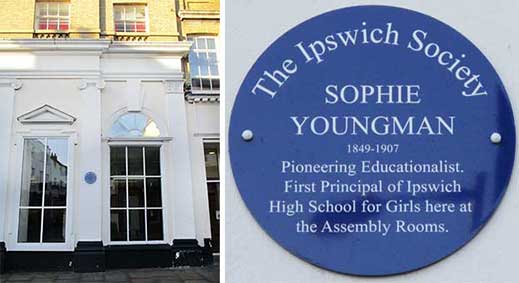 2022
images
2022
images
SOPHIE YOUNGMAN (1849-1907)
5 Northgate Street. Harriet
Sophie Youngman was born in Daventry. She came to
Ipswich as the first Principal of the Ipswich High School for Girls,
when it opened in 1878 at the Assembly Rooms in Northgate Street. The
school was established by The Girls Public Day School Company to
provide good and affordable education with a wide curriculum. Miss
Youngman led and developed the school for 21 years. She was considered
a strong and wise woman, challenging local prejudice about schooling
for girls. Her leadership and support helped many local girls to enter
university education for the first time and to gain professional
qualifications. It was also the first time that girls were introduced
to physical education and sports in an educational setting. This plaque
was unveiled on 11 December 2019. (This is the second Blue Plaque to be
placed on the Manor House, the other is to Nathaniel Bacon: a rare
event but one which indicates the historical importance of this eminent
building.)
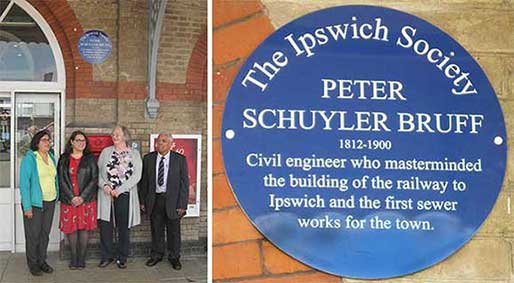 2019
image
2019
image
PETER SCHUYLER BRUFF (1812-1900)
Ipswich railway station.
The plaque was unveiled on 17.6.2019 by descendants of the great
engineer, Peter Bruff. The Ipswich Society worked with Abellio Greater
Anglia to site the plaque on the outside wall of the entrance hall,
beneath the station canopy and above the fine Victorian postal wall
box. Mervyn Russen was the sponsor of the plaque and he researched the
family members, some of whom were unaware of their relationship to
Bruff. Peter Schuyler Bruff left his mark on Ipswich and elsewhere. He
engineered the extension of the railway, along with John Chevallier
Cobbold, for the Eastern Union Railway; initially the line stopped at
Station Street/Croft Street because of the mass of Stoke Hill. To
facilitate the further extension of the line to Bury St Edmunds (and
eventually to Norwich), Bruff was the mastermind behind the tunnel
through the 'Stoke Bone Beds' (named after the fossil deposits
unearthed there – see also the plaque to Nina Frances Layard below.
Bruff was the man behind the construction of the sewage system in
Ipswich, saving many lives from cholera in the process, and he
established the seaside resort of Clacton in Essex.
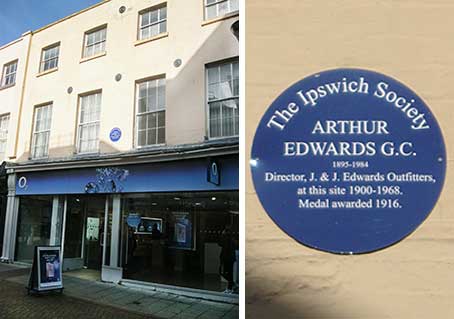 2019
image
2019
image
ARTHUR
FREDERICK EDWARDS, GC (1895-1984)
35 Tavern Street, Ipswich. Arthur Frederick Edwards, GC
(1895-1984) was awarded the George Cross
in 1971 having received the Edward Medal in 1919 (now in the Ipswich
Museum). The award was for bravely assisting, with three other
soldiers, in the rescue of wounded at Faversham Powder Mills store,
Kent, when serving as a Bombardier in the Royal Artillery in April
1916. The store which contained 200 tons of TNT was afflicted by a
chain of explosions which Edwards and his colleagues prevented while
saving many wounded and inspiring others to assist. Arthur was educated
at Ipswich Grammar School and Bishop’s Stortford School. He became a
director of the department store, J&J Edwards, which was based at
33-35 Tavern Street from 1900-68. The retailer was founded by Arthur
Edwards’ father, James F Edwards, and his uncle. The plaque was
unveiled in November 2018.
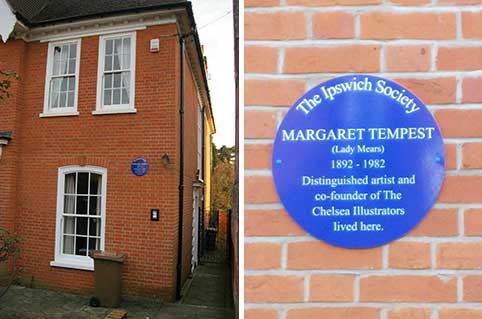 2016
image
2016
image
MARGARET
TEMPEST (Lady Mears) (1892-1974)
3 St Edmunds Road, Ipswich. Margaret Tempest was born at 28 Fonnereau
Rd Ipswich, later moving to
34 Park Rd. She attended Ipswich Art School and Westminster School of
Art, graduating in 1914. She was a founder member of the Chelsea
Illustrators: a society of twenty women illustrators, who successfully
worked together between 1919 and 1939. Margaret is credited with the
distinctive design of Alison Utley’s Little Grey Rabbit books, which
she illustrated from 1929 into the 1960s. She illustrated her own books
as well as those of a wide range of authors. From London, Margaret
returned to Suffolk many weekends to pursue her passion of sailing. In
1939 Margaret moved permanently to the Ipswich area and married Sir
Grimwood Mears. They moved to 3 St Edmunds Rd in January 1951, where
Lady Mears continued living until her death. A long-time member and
committee member of Ipswich Art club, she exhibited her artwork till
the age of 82.
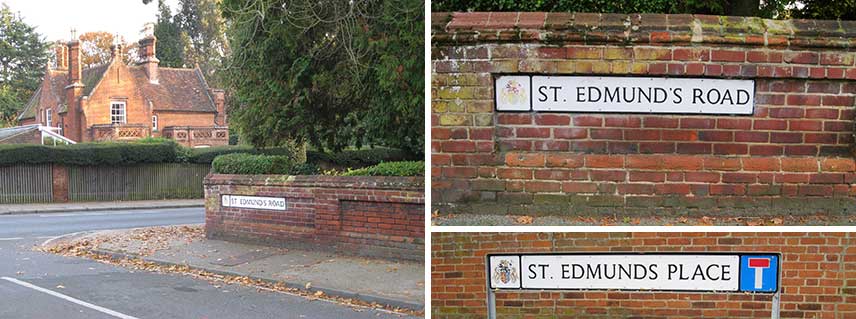
While we're in this road, let's note one of the few street
nameplates in Ipswich to use the possessive apostrophe in: "ST.
EDMUND'S ROAD" (which isn't to be found in the more recent 'St.
Edmunds Place' – but both include the unnecessary full stop after 'St').
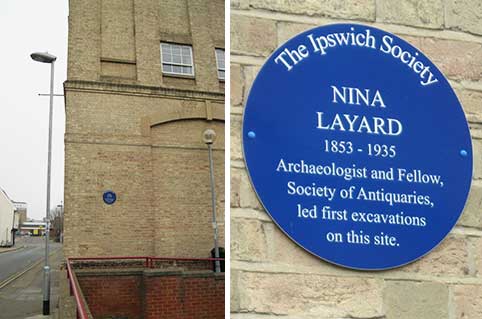 2017 image
2017 image
NINA FRANCES LAYARD (1853-1935)
Unicorn House
Foundation Street, Ipswich. Nina Layard was an archaeologist and
writer. She is credited with the
first excavations of the old Dominican Friary in Blackfriars,
Foundation Street in 1898. Her work on the Valley Brick field in
Foxhall Road, has been acknowledged as highly significant, and her
paper on the Hadleigh Road Anglo-Saxon site was presented to the
Society of Antiquarians in London, where she was one of the first women
to become a Fellow. Following a newspaper appeal by her, public
subscriptions were raised for the memorial to nine Ipswich Martyrs
(now) in Christchurch Park (1903). She also published Seventeen Suffolk
Martyrs and other local history books. She was a founder member and
first woman president of the Prehistoric Society of East Anglia.
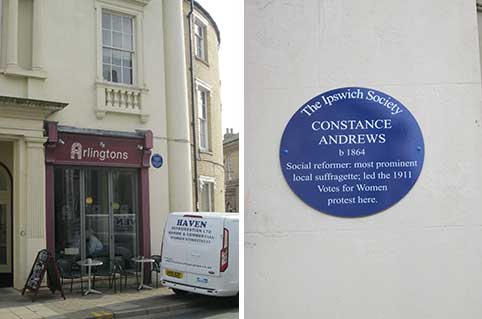 2016
images
2016
images
CONSTANCE ANDREWS (b. 1864)
Arlington’s
Restaurant Museum Street, Ipswich. Constance Andrews was a leading
Ipswich suffragette, was committed to
social justice and the campaign for Votes for Women. She formed the
local branch of the campaigning group The Women’s Freedom League. This
inspired a group of women who demonstrated, held meetings, organised
propaganda events, and carried out acts of civil disobedience – all to
gain support and put pressure on the government to give women the vote
on equal terms with men. In 1911 she organised the ‘No Vote, No Census’
protest in Ipswich, when about thirty women spent the night in the Old
Museum Rooms to boycott the Census. Later she spent a week in Ipswich
prison after refusing to buy a dog licence – part of a No Vote, No Tax
campaign. She was met at the prison gates by a large crowd of
supporters, and processed in a carriage through the streets to a
celebration breakfast at 16 Arcade Street.
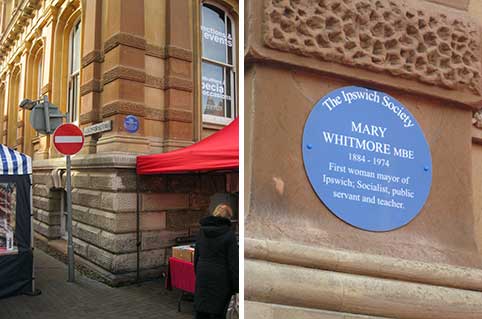
MARY WHITMORE (1884 – 1974)
A smaller-that-usual sized plaque on the eastern
pilaster of the Town
Hall frontage. Mary Whitmore was the first woman mayor of Ipswich. Her
interest in politics began when she joined the suffragette movement at
the formation of the Ipswich branch of the Women’s Social and Political
Union, (WSPU). After joining the Labour party in 1924 she was elected
as a councillor in 1930 and was very active in, and chaired a number of
public health committees. One of the founder members of the local
Workers Education Association (WEA), she was secretary from 1929-39. A
pioneer of women’s suffrage, education and public services she was
described by Doris Young, (a member of the National Labour Women’s
Advisory Committee), as a socialist, pacifist, and internationalist.
Whitmore was Mayor in 1949-50 and was awarded the MBE in 1951 for her
contribution to public services.
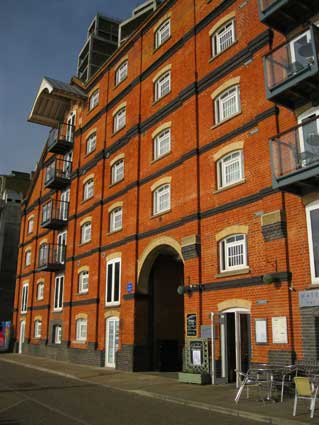
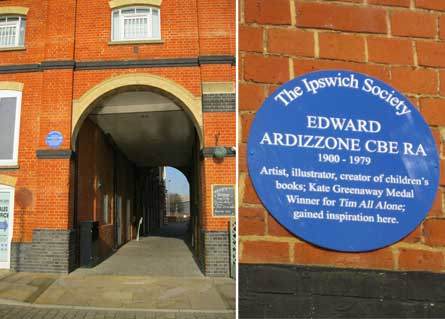 January
2015
January
2015
EDWARD ARDIZZONE
(1900-1979)
This is the red brick Paul's
maltings
on Albion Wharf, probably the
most handsome of the Wet Dock
buildings. (Because Paul's Maltings owned so many structures around the
dock, developers/planners seem to have favoured calling this building
"Cambria".) Ardizzone had strong links
with Ipswich. A (not entirely happy) pupil of Ipswich School in the
early 1900s, he often wandered around the Wet Dock for inspiration,
eventually becoming a noted artist, book illustrator and author. His
capturing on paper of local characters in the streets and in the many
local pubs showed his characteristic loose line-work.
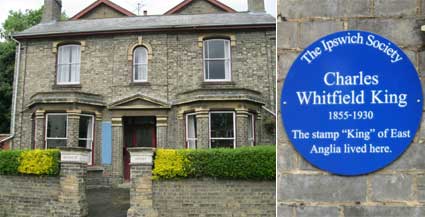
CHARLES WHITFIELD KING
(1855-1930)
Unveiled in June 2014, this celebrates one of the
biggest international
traders in postage stamps from his premises on both sides of Lacey
Street. For much more on this, see our Morpeth
House page.
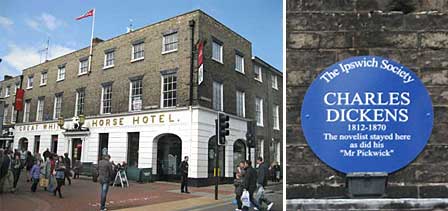
CHARLES JOHN
HUFFAM DICKENS
(1812-1870)
The
Great White Horse, Tavern Street. The English writer and social
critic created some of the world's most
memorable fictional characters and is generally regarded as the
greatest novelist of the Victorian period. During his life, his works
enjoyed unprecedented fame, and by the 20th century his literary genius
was broadly acknowledged by critics and scholars. His novels and short
stories continue to be widely popular. In 1835, Charles Dickens stayed
in Ipswich and used it as a setting for scenes in his novel The Pickwick Papers. The hotel
where he resided first opened in 1518; it was then known as The Tavern
and later became known as the Great White Horse Hotel. Dickens made the
hotel famous in chapter XXII of The
Pickwick Papers, vividly describing the hotel's meandering
corridors and stairs.
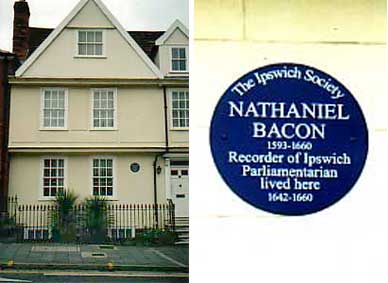
NATHANIEL BACON
(1593-1660)
Manor House, St Margaret's Green.
This address was the house occupied by the
Cobbold family when their celebrated servant Margaret Catchpole stole
their prize horse to ride to the rescue of her lover in London; she was
imprisoned in Ipswich Gaol, escaped, was recaptured, sentenced to death
and eventually transported to Australia. Nathaniel Bacon, described as
a "pious, prudent learned man", was a
member of the Bacon family which achieved great prominence nationally
under Elizabeth I. Nathaniel was a key figure in Ipswich political life
in the mid-17th century. He became its leading lawyer – the
Recorder; its MP from 1646 to 1660; and its historian, being the
compiler, in 1654, of The Annalls of
Ipswiche, The Lawes Customes and
Government of the Same.
During the Civil War he was Chairman of the Eastern Association
Committee and a strong supporter of the Puritan cause. This made him
very important regionally and nationally as an administrator and
organiser during the War and the period of Commonwealth government,
although he was opposed to the execution of Charles I and to the
proclamation of the Commonwealth. See
also: Margaret Catchpole plaque above.
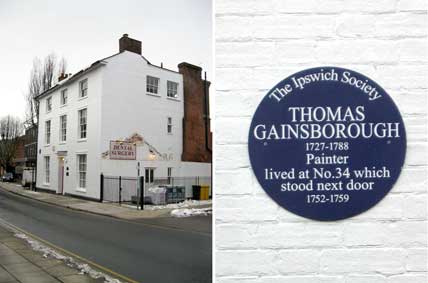
THOMAS
GAINSBOROUGH (1727-1788)
32 Foundation Street.
The great Suffolk artist Gainsborough was born and educated in Sudbury,
where he has long been properly honoured with a statue on the Market
Hill. It is less well known that he spent seven formative years in
Ipswich, 1752-1759. After a few years of apprenticeship in London, he
had returned to
Sudbury in 1748 but he moved to Ipswich in 1752 because commissions for
portraits were more easily obtained here. He rented 34 Foundation
Street, a house similar to No 32 where the plaque is mounted. No 34 was
shamefully demolished in the early 1960s. As well as painting portraits
and landscapes in Ipswich, Gainsborough
was an enthusiastic member of the Ipswich Music Club. He played several
keyboard and stringed instruments. He moved to Bath in 1759; the
fashionable spa gave him more
opportunities for meeting and painting rich patrons. But it is
appropriate that Christchurch Mansion in Ipswich houses one of the best
collections of Gainsborough's paintings outside London, and that it
includes one of his finest works, the portrait of William Wollaston, MP
for Ipswich, playing the flute.
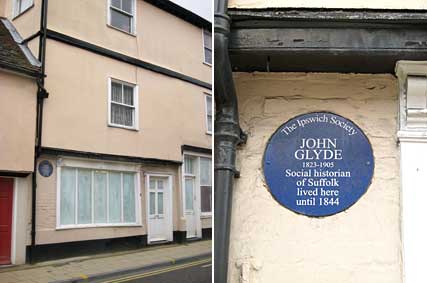 and next door:
and next door: 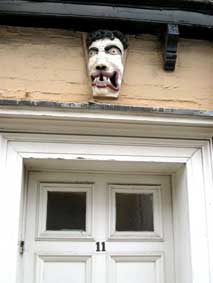
JOHN GLYDE
(1823-1905)
9 Eagle Street. John Glyde is recognised as the
foremost 19th century historian of
Ipswich and Suffolk, the author of books which are still standard
reference works on the social and economic aspects of the town and
county. A radical thinker, he was involved in many organisations
working for the social and cultural improvements of Ipswich, including
the founding of a Free Library for the town (see our Rosehill case study page for more on
the story of Ipswich libraries). His bequest of books and
manuscripts to the Ipswich Corporation in 1905
is now in the Suffolk Record Office, Ipswich. During his working life
he was a bookseller, an agent for domestic servants and a registrar of
marriages.
See our Spread Eagle page for more
about these premises, the butcher's shop and the ogre.
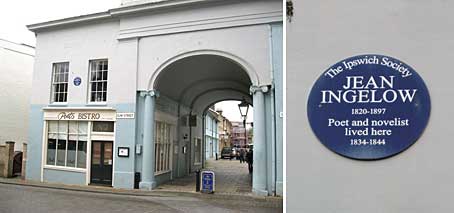 and under the arch:
and under the arch: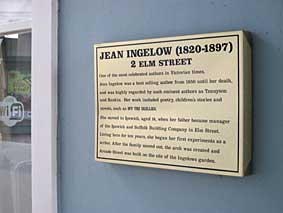
JEAN INGELOW
(1820-1897)
2 Elm Street. Note that the rectangular information
board was removed
from inside the arch before 2020. One of the most celebrated authors in
Victorian times, Jean Ingelow's
fame declined to almost nothing during the 20th century, although there
is still a Jean Ingelow Society in America. However, she was one of the
best selling authors from 1850 until her death and was highly regarded
by such eminent authors as Tennyson and Ruskin. Her work included
poetry (the best known of which was A
High Tide on
the Coast of Lincolnshire, still widely anthologised in the
mid-20th
century), children's stories and novels, such as Off the Skelligs (most
of which is still very readable). Born in Lincolnshire, at the age of 14 she moved to
Ipswich when her father
became manager of the Ipswich and Suffolk Banking Company in Elm
Street. Living here for ten years in the spacious first floor rooms
over the bank she began her first experiments as a writer. After the
bank failed and the family moved out, the arch was created and Arcade
Street was built on the site of the Ingelows' garden.
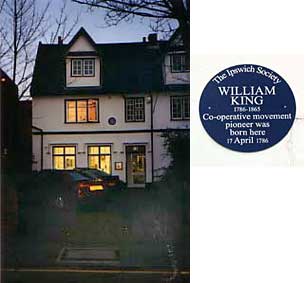
WILLIAM KING
(1786-1865)
"The Master's House",
19 Lower Brook Street. King was born at
19/21 Lower Brook Street where his father, The Rev
John King, was Master of Ipswich (Grammar) School in that building.
William King became a physician, working in Brighton, but he is
celebrated as a founder of co-operative democracy. He created a
Co-operative Benefit Fund and a Co-operative Trading
Association. He also founded and wrote the periodical The Co-operator
(1828-1830) which helped to inspire the "Rochdale pioneers" of the
Co-operative Movement later in 1844. It seems fitting that in Ipswich,
where Co-operative retailing had – until the
closure of of almost all
of the town centre store in 2010 – held its own remarkably well, we
should acknowledge this pioneer of the social and philosophical
principles of Co-operation, even though this work was done after he
left Ipswich. The building on which this plaque is displayed was
originally known as The Preacher's House; the change of name came when
it became occupied by the Master of The Ipswich Grammar School,
forerunner of The Ipswich School on Henley Road. William King was the
son of one of the Masters, Rev. John King. At the time there was a high
wall in front of the house with a large yard/garden/playground (about
30 by 80 feet) at the rear stretching back to a rear gate opening onto
Foundation Street, opposite the rest of
the school in part of the
remaining Blackfriars buildings (in the first floor fomer friars'
dormitory, the refectory schoolroom having been demolished in 1766),
also Christ's Hospital School
and the Shire Hall. Dancing classes
were held on the upper floor of the Master's House. See the Christ's Hospital School page
for a sketch map of the area.
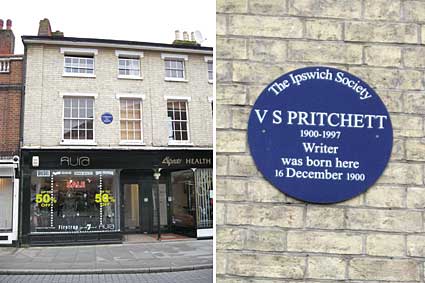
V S PRITCHETT
(1900-1997)
41 St Nicholas Street.
The plaque simply calls V S Pritchett a "writer" because he excelled in
so many genres of writing that there wasn't room to specify! He is
regarded as arguably the finest English short story writer of his time.
He also published novels, travel books, literary criticism, reviews and
an absorbing autobiography, A Cab at
the Door, in which he explained
how his father, a London businessman in financial difficulties, lodged
with his wife over a toyshop at 41 St Nicholas Street. Here baby Victor
was born a century ago on 16 December 1900. The family returned to
Ipswich in 1910, living for a year in the
Cauldwell Hall Road area. Pritchett was
knighted in 1975 and was made
Companion of Honour in 1993. He died in 1997. The plaque records him as
"V S Pritchett", rather than "Sir Victor
Pritchett, CH", because that is how he signed himself as a writer and
is known to all his readers.
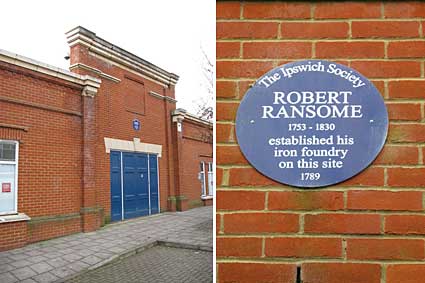
ROBERT RANSOME
(1753-1830)
Old Foundry Road. For
the best part of two centuries, Ransome's
was probably the most
famous Ipswich name around the world — certainly as far as
manufacturing was concerned. Robert Ransome came to Ipswich from
Norwich in 1789 to set up an iron foundry, first briefly near St Mary
at Quay and then soon after in that year at St Margaret's Ditches,
now
Old Foundry Road, where the street name still commemorates the site.
The works, in time, stretched from Great Colman Street to Carr Street.
Still under family control after Robert's death, the foundry closed on
this site in 1849, moving to the dockside, and the firm eventually
became Ransomes Sims and Jefferies, making agricultural machinery,
lawnmowers, etc. Later another company, Ransomes and Rapier, was
created making heavy engineering products such as dragline cranes,
railway equipment and large sluice gates for dams. Robert Ransome was
one of a group of highly influential Quakers in the
town. He set up a fund for employees unable to work through sickness or
injury. He was also instrumental in bringing gas lighting to Ipswich,
installing a gasmaking plant in part of his foundry.
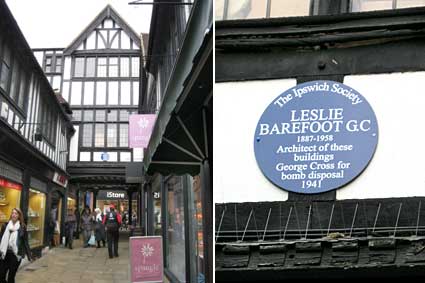
LESLIE BAREFOOT
G.C.
(1887-1958)
The Walk (1938). H.J. Leslie Barefoot G.C. was the architect of the
small central
pedestrian shopping streets in the centre of Ipswich known as
Thoroughfare (the older of the two) and The Walk, the latter of which
is the site of his
plaque. Born in Dulwich he married in 1913 and served in The Great War
with
distinction. In 1920 he moved to Ipswich with his family and during the
inter-war period designed buildings throughout East Anglia, becoming
president of the Suffolk Association of Architects. Re-joining the army
in 1939 in the Royal Engineers he volunteered to form a new unit to
deal with unexploded bombs. The George Cross database indicates:
"During the early days of the blitz Major Barefoot, who was a pioneer
in bomb disposal dealt with some of the first unexploded bombs which
fell on Britain. He was able to put invaluable information at the
disposal of the authorities." His citation in 1941 for the George Cross
states: "for most conspicuous
gallantry in carrying out hazardous work in a very brave manner." He
was the first Army officer to receive the GC. He is also commemorated
by a plaque in Westminster Abbey together with the other recipients of
the George Cross. See also
our Cornhill page (under 'Cornhill
Chambers') for more on Barefoot's partner, H. Munro Cautley.
Below: it
is worth including here a dated '1885' rainhopper (51 years before The
Walk was built) –
complete with roosting pigeon – spotted in the lower
section. This is at the rear of the shop fronting
Butter Market which was for many years the Noble Romans pizza
resturant,
but more recently a clothiers. The splendid neo-medieval carving and
fenestration by Henry Munro Cautley, which characterises The Walk, can
also be seen. Such dated rainhoppers
are gathered together on their own page. The builder of these
pedestrian ways was V. A Marriott.
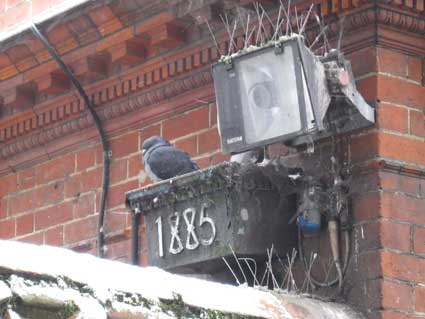
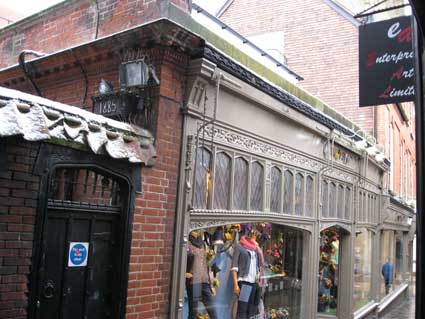 2013 images
2013 images
See our page on Public clocks in Ipswich for a 2018 view of the
Tavern Street entrance and its clock. During refurbishment of The Walk
in the 21st century, this blue plaque was resited to a lower position,
perhaps making it more noticeable and readable.
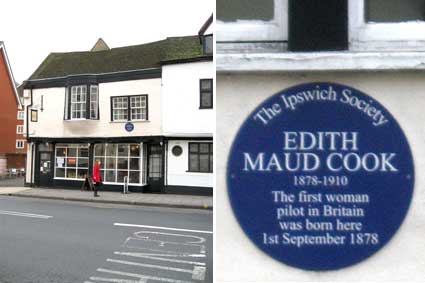
EDITH
MAUD COOK (1878-1910)
90 Fore Street. Edith Maud Cook was born at 90 Fore Street on
1st September. She was a
balloonist, a parachutist and is stated, on the RAF Museum website to
have been the first woman pilot in the United Kingdom. Edith made
around three hundred balloon ascents and demonstrated the
use of parachutes over a period of ten years. After she learned to fly
in early 1910 she made several solo flights but did not obtain a
pilot's licence before July of that year. On 11th July 1910 as reported
in The Times: "Miss Viola Spencer (a
pseudonym) in a parachute descent at Coventry on Saturday, alighted on
a factory roof. The parachute turned over and Miss Spencer fell onto
the roadway injuring herself severely." She died on 14th July as a
result of her injuries. In her book Before
Amelia Eileen Lebow tells the remarkable story of the world's
women
pioneer aviators who braved the skies during the early days of flight.
At a time when the mere sight of ladies wearing trousers caused a
sensation Edith Maud Cook was one she praises as an adventurer and a
very courageous woman.
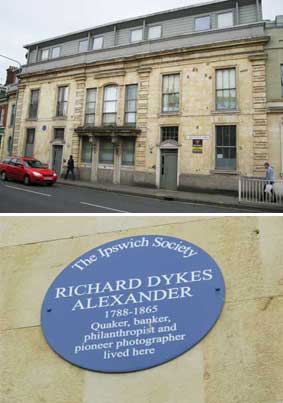
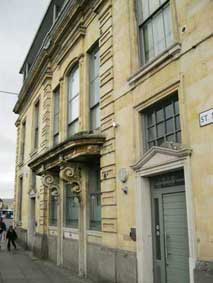
RICHARD DYKES ALEXANDER (1788-1865)
Alexander
House, 73 St Matthews
Street. The son of Dykes
Alexander (1763-1849)
was a noted Quaker
banker, photographer and philanthopist of the town. Richard built his
house
on the corner of St Matthews Street and Portman Road; long empty, this
distinguished building was in 2009 extended and refurbished as flats.
Although it has a 'bank-like' facade, suggesting a previous use (the
Alexander Bank on Bank Road was well known from the 18th century – see Street name derivations), the structure
was built as the Alexanders' home in the fields to the west of the town
c.1840 and must have included a considerable parcel of land. When
Richard Dykes Alexander made much of this land available for housing in
the
1850s he stipulated that some of the street names should be those of
leading slavery abolitionists.
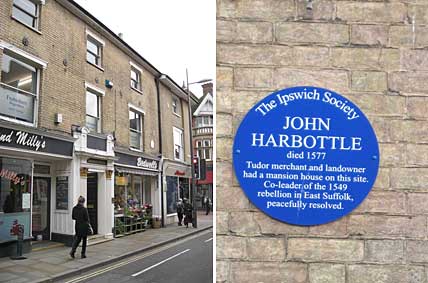
JOHN HARBOTTLE (d.1577)
2-4 Northgate
Street. The wealthy wool merchant and
landowner was
Chamberlain in the town in 1542. In 1549 Harbottle was co-leader of the
Suffolk contingent of Kett's Rebellion; the conflict here was
peacefully resolved, as attested by the blue plaque text. However...
Kett's Rebellion was a revolt in Norfolk during the reign of
Edward VI (1537-1553), largely in response to the enclosure of land. It
began at Wymondham on 8 July 1549 with a group of rebels destroying
fences that had been put up by wealthy landowners. One of their targets
was yeoman farmer Robert Kett who, instead of resisting the rebels,
agreed to their demands and offered to lead them. Kett and his forces,
joined by recruits from Norwich and the surrounding countryside and
numbering some 16,000, set up camp on Mousehold Heath to the north-east
of the city on 12 July. The rebels stormed Norwich on 29 July and took
the city. But on 1 August the rebels were defeated by an army led by
the Marquess of Northampton who had been sent by the government to
suppress the uprising. Kett's rebellion ended on 27 August when the
rebels were defeated by an army under the leadership of the Earl of
Warwick at the Battle of Dussindale. Kett was captured, held in the
Tower of London, tried for treason, and hanged from the walls of
Norwich Castle on 7 December 1549.
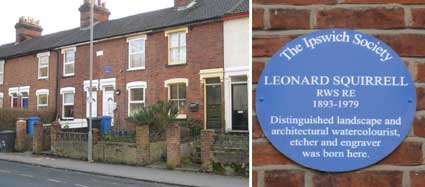
LEONARD
SQUIRRELL
(1893-1979) 82
Spring
Road.
Leonard Squirrell
was born
in Ipswich.
He studied art at
Ipswich School of Art 1908-1916 under George
Robert Rushton, then at
the Slade School of Fine Art in 1921 under Henry Tonks. Exhibited at
the Royal Academy, RWS, RI and RSA. Squirrell won a number of medals
for his etchings, a technique of which he was a master. His work is
held in many public and private collections, including the Victoria
& Albert Museum, British Museum and Fitzwilliam Museum in
Cambridge. His most famous painting is a view of the Wet Dock drawn from a vantage
point atop the gasometer. It is difficult to over emphasise the
importance of Squirrell as a documenter of ipswich, Suffolk and the
wider world. His drawing style might be considered by some 'old
fashioned', meaning showing great draughmanship and accuracy while
delivering a visually pleasing, excellent result. His colour work is
the match of his beautiful pen and ink drawings.
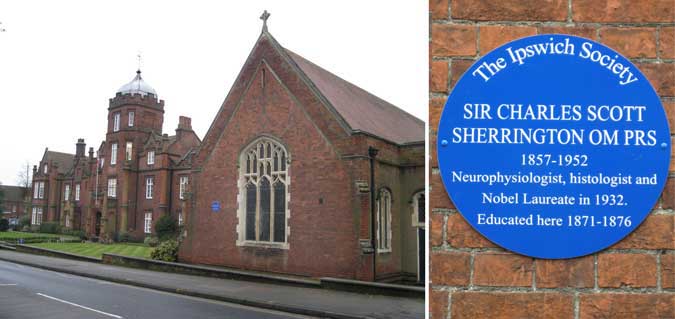
SIR CHARLES SCOTT SHERRINGTON
(1857-1952) The Ipswich School, Chapel wall, Henley
Road The English neurophysiologist, histologist, bacteriologist, and a
pathologist, Nobel laureate and, in the early 1920s, president of the Royal
Society was educated at The Ipswich School. He received the Nobel Prize
in Physiology or Medicine with Edgar Adrian, 1st Baron Adrian in 1932
for their work on the functions of neurons. Prior to the work of
Sherrington and Adrian, it was widely accepted that reflexes occurred
as isolated activity within a reflex arc. Sherrington received the
prize for showing that reflexes require integrated activation and
demonstrated reciprocal innervation of muscles (Sherrington's Law).
Sherrington entered Ipswich School in 1871. Thomas Ashe, a famous
English poet working at the school, served as an inspiration to
Sherrington. See our Street name derivations
for a note on Sherrington Road.
Next to this chapel wall is an entry to the public school with a carved
stone tablet: 'IPSWICH SCHOOL – MERMAGEN HOUSE':
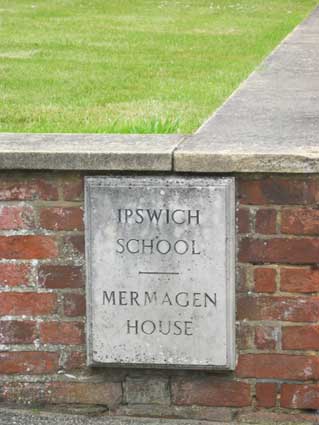
Patrick Hassell Frederick Mermagen
(8 May 1911, Colyton, Devon – 20 December 1984 Ipswich, Suffolk) was a
public school teacher and cricketer who played eight first-class
matches for Somerset in 1930. He was headmaster of Ipswich School
(1950–1972).
Across the road is the Brett fountain
and lodge house. See also
our Curson Lodge page for further
photographs of Ipswich School.
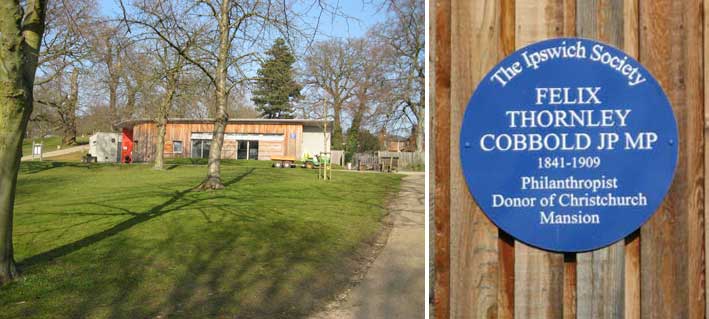
FELIX THORNLEY
COBBOLD (1841-1909)
This corner of Christchurch Park
was
in a sorry state for many years
with the cabman's shelter which has been vandalised by fire wrapped up
in tarpaulins nearby. Built in 1892, the cabman's shelter which once
stood on
Cornhill, was in 1895 pulled by a seamroller to a site north-east of
the round pond, then ended up in 1995 burnt and neglected. In 2006 it
was virtually rebuilt
and re-erected close to the Westerfield Road entrance. In addition the
'green-roofed' Reg Driver Visitor Centre was been built in 2007 (it
bears
the Cobbold blue plaque) and the Bolton Lane park gateway with its
stone pineapples and lodge house is a much more welcoming and
attractive way into our principal town park. Apparently it was not
possible to mount the plaque on either the Mansion or the Soane Street
gateway, for conservation reasons. Felix was the son of John Cobbold,
Member of Parliament for Ipswich, and his wife Lucy, daughter of
Reverend Henry Patterson. John Cobbold, Thomas Cobbold and Nathaniel
Cobbold (grandfather of Cameron Cobbold, 1st Baron Cobbold) were his
elder brothers. He was educated at King's College, Cambridge, and later
became a senior fellow of this college. Cobbold also sat as Member of
Parliament for Stowmarket in Suffolk between 1885 and 1886, and for
Ipswich between 1906 and his death. What else can be said about Felix
Thornley Cobbold which hasn't already been said? Arguably the ultimate
Ipswich
philanthropist (possibly W.F. Paul
is in the running) who has left his mark in many ways on the town: in
1892 he
bought and presented to the town Christchurch
Mansion (gently twisting
the Borough's arm to save the surrounding parkland from housing
developers). He donated to Ipswich the land for St.
Clement's Baths (Fore Street Baths), a
clock and carillon for St. Clement's Church and 45 acres of Gippeswyk
Park plus cash for fencing. He even had a hand in the establishment
of Rosehill Library on the east
of the
town (W.F. Paul was also a subscriber). Although coming from a
staunchly
Conservative family (his father and two brothers had been Conservative
MPs), Felix showed his radical leanings by being elected Liberal MP for
Stowmarket in 1885 and Ipswich in 1906. He had already been Mayor of
Ipswich in 1897. The Cobbold Family History Trust (see Links) has funded a display of material inside
the Centre about Felix Thornley Cobbold. Incidentally, the Centre was
named after Reg Driver, the first Chairman of the Friends of
Christchurch Park.
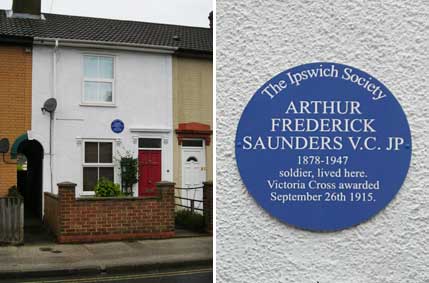
ARTHUR FREDERICK SAUNDERS
(1878-1947) 180 Cauldwell Hall Road. Arthur Saunders
lived here at the time he was awarded the Victoria
Cross, the first such decoration ever awarded to the Suffolk Regiment
or a citizen of Ipswich. With this and the plaque for Leonard Squirrell
(above) we see that the award of a Blue Plaque is not confined to the
wealthy and the upper classes.
We are indebted to The Ipswich Society for the bedrock of the
Blue Plaque
information.
The excellent work of this organisation in
researching and recognising important as well as quirky buildings,
streets and people in the story of Ipswich is invaluable; evidence of
this can be found in the growing number of newly installed plaques for
which they raise funds. Go to their website
(see Links), click on the Plaques link, see
more images and download their leaflet on Blue Plaques.
OTHER PLAQUES (placed on buildings and
elsewhere over time
by a variety of bodies)

Mounted on the refurbished Holywells
Stable Block:
'Civic Voice Design Awards 2016
Public Realm Category
The Holywells Park Project
Winner'
Note that a similar award and
plaque, well-deserved, was given to Quay Place (St Mary-At-Quay Church) in 2017.
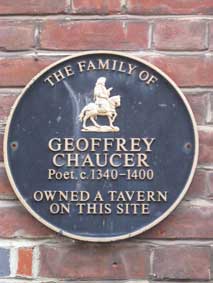 (replaced
an earlier cast iron plaque)
(replaced
an earlier cast iron plaque)  Library window
Library window
The family of Geoffrey
Chaucer
21 Tavern Street (plaque is low on the right side wall
in Tower St). The Malyn family of Ipswich
and London, vintners, took
the name of
Chaucer, derived from the trade of leather working, with which they
were also associated. The Chaucer/Malyns including Geoffrey Chaucer's
grandfather, owned and occupied premises on this site in the 13th and
14th centuries. Geoffrey Chaucer is commemorated by a full-length
likeness, based on a 16th century portrait, in a stained glass gothic
window in the Reading Room of the Carnegie Library in Northgate Street
(known variously as Ipswich Library, Ipswich
Central Library and Ipswich
County Library).
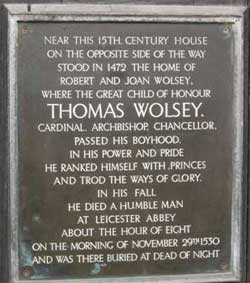
Thomas Wolsey
(1475-1530)
47 St Nicholas Street. Thomas Wolsey,
Cardinal of the Church, Archbishop of York and
for 14 years
Lord Chancellor of England for Henry VIII, was, next to King Henry
himself the most powerful man in the realm. The plaque, mounted on
Curson Lodge, a building of appropriate
age, reminds us that Wolsey's
boyhood home stood on a site on the opposite side of the street. His
birthplace is likey to have been in the parish of St Mary-At-Elms,
perhaps on the site of the Black Horse Inn.
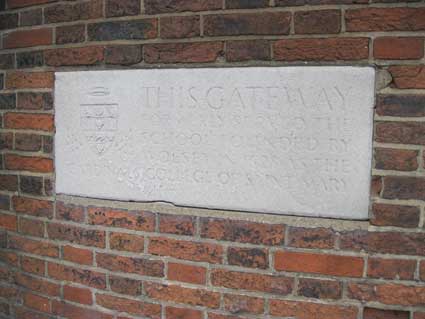 2013 image
2013 image
Wolsey Gate,
College Street
This modern tablet set into the curved wall to the right of the
famous gateway is showing signs of the erosion which besets the gate
itself.
'THIS
GATEWAY
FORMERLY SERVED THE
SCHOOL FOUNDED BY
WOLSEY FOUNDED IN 1528 BY THE
CARDINAL'S COLLEGE OF ST MARY'
Much more on the Wolsey Gate on our Curson
Lodge page.
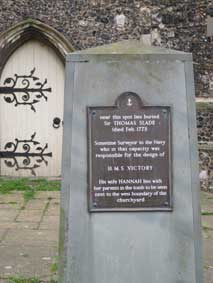
Sir
Thomas Slade
(1703/4-1771)
Like a section from Finnegans
wake, this plaque on a
large stone obelisk near the west door of St
Clement Church, is
remarkably free of punctuation. Starting with the lower case 'near' and
trailing off with 'churchyard', the text is topped by an anchor symbol.
'near this spot lies buried
Sir THOMAS SLADE
(died Feb. 1771)
Sometime Surveyor to the Navy
who in that capacity was
responsible for the design of
H.M.S. VICTORY
His wife HANNAH lies with
her parents in the tomb to be seen
next to the west boundary of the churchyard'
The tiny Slade Street running
between Star Lane and Salthouse Street was, in the 20th
century, named after Sir Thomas Slade. According to N.
A. M. Rodger in The Command of the
Ocean: a naval history of Britain, 1649-1815: "The ships which
[he] designed...were admirably suited to Britain's strategic
requirements...By common consent, Slade was the greatest British naval
architect of the century...it was generally agreed (even by themselves)
that his successors, though competent designers, never matched his
genius."
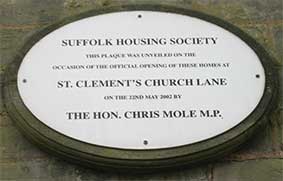 Plaque in St
Clements Church Lane.
Plaque in St
Clements Church Lane.
[There is also an (almost unreadable) information plaque on the nearby
St Mary-at-Quay Church.]
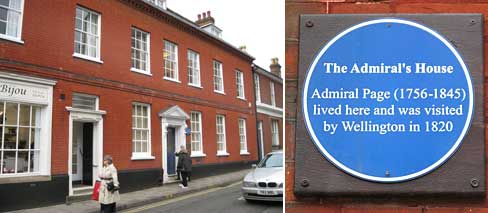
Admiral Benjamin Page
(1765-1845)
13 Tower Street ("The Admiral's House"). The plaque on this building commemorates the
Ipswich-born admiral who
lived here on his retirement after a distinguished naval career. He was
made an honorary freeman of the borough in 1835. His portrait and
paintings of six naval actions in which he took part, which he gave to
the town, hang in the library room of the Town Hall. The house was
probably built during the reign of Charles II (1660-85), with the later
addition of a fine Georgian front. The interior is a mix of
architectural styles. Once the residence of Admiral Benjamin Page and
visited by the Duke of Wellington in 1820, it later became the home of
eminent local architect, John Shewell Corder (see our Scarborow page).
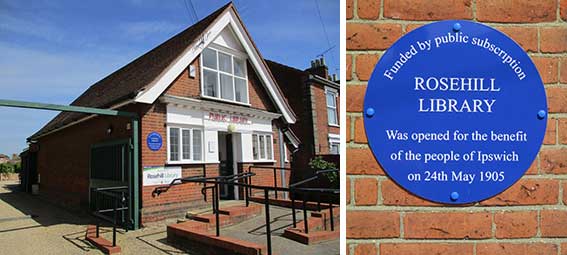 2022
image
2022
image
Rosehill Library
has an interesting place in the story of Ipswich and of the national
public library service. This is covered on our Rosehill case study page and now
commemorated by a plaque instigated by the Friends of Rosehill Library
group and Suffolk Libraries. The style of design mirrors blue plaques
by The Ipswich Society, which in turn pay homage to the original
English Heritage ceramic plaques in London.
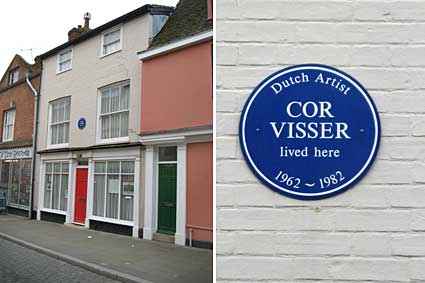
Cor Visser
(1903-1982)
44 Fore Street. Born in Holland,
the artist settled in Ipswich after
the Second World
War, during which he was the official war artist to the Dutch
government in exile. He lived for some years on a boat in Ipswich dock,
finding inspiration particularly in dockside and river scenes, before
making his
studio and home in Fore Street in 1962. Ipswich
Museum collections
contain some of his works. The commemorative blue plaques which people
recognise on London's buildings are installed and cared for by English
Heritage. Although some may assume that such plaques found elsewhere in
the country are also placed there by E.H., they are usually the work of
the local civic society. This accounts for the wide variety of
size, style and colour to be found in different towns and cities. The
Cor Visser memorial shown above was the first 'blue plaque' to be
installed in Ipswich and it was designed (based on the English Heritage
model) and funded by the late Brian Jepson, who lived at the house in
Fore Street. As a friend of the Ipswich Society (see Links), it was not a great
leap to use his design template and advice for the production of the
present series of 'Ipswich Society' blue plaques illustrated on this
page, which started to appear in 2001. Brian was Ipswich-born and
joined Johns Slater Haward arcitectural practice as an office boy,
training himself as an architect and finally working for the local
authority. He was a man of many parts, not least an excellent painter
of buildings and landscapes. He sadly died in 2014.
And lest we forget...
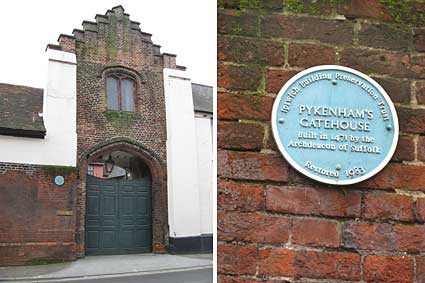
Pykenham's Gatehouse
Northgate Street. Pykenham's Gatehouse opposite the County
Library was built in 1471 and
is famous for its Tudor brick front and half-timbered rear elevation.
It is almost all that remains of the former
Archdeacon's Palace (other parts are probably buried inside the
structure of the much-altered Ipswich & Suffolk Club). It was
restored by the Ipswich Building Preservation Trust (see Links) in 1983, their
first ever project.
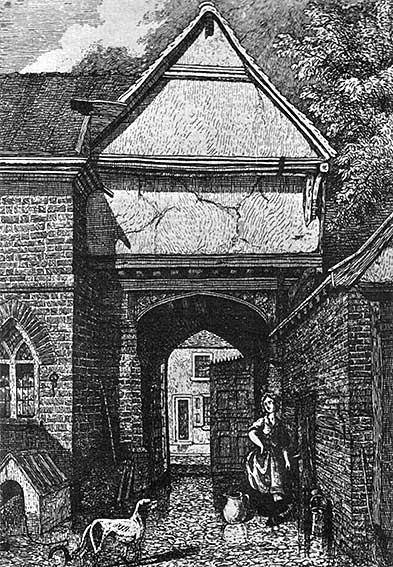 1845
1845
'The gateway situated in Northgate Street
was the entrance to the residence of William Pykenham L.L.D.,
Archdeacon of Suffolk, Dean of the College of Stoke Clare and
Chancellor of Norwich, 1471.' The engraving above
is from Frederick Russel and Wat Hargreen's Picturesque Antiquities of Ipswich
(published in Ipswich, 1845). The view illustrated is from today's
Ipswich & Suffolk Club – windows have been opened up in the
gatehouse in the later
restoration by Ipswich Building Preservation Trust; the site of the
future Public
Library is visible through
the gateway. The outbuilding to the right has been demolished and a
door on the right of the arch now leads up to the upper levels.
Bev Bowry and her husband have been 'researching Edward Bacon and his
son George and their families [and] I have become very fond of these
predominantly humble and philanthropic gents so if I feel the roles
they played have been overlooked in any way I try and put this right...
In view of the fact that you gave a talk a few months ago at the
Ipswich and Suffolk Club about historic lettering in Ipswich, which my
husband and I attended and thoroughly enjoyed, I thought you may be
interested to know that whilst researching these Bacons we discovered
that Edward Bacon bought the lease to the Archdeacon's House in 1859
from a John Cobbold (presumably John Wilkinson Cobbold). This was
passed down to George and then to George's wife Harriet who sublet it
to the Ipswich and Suffolk Club. We were totally staggered when we
discovered that!' Members of the Bacon family appear on our Cornhill page under 'Lloyds
Bank and Lloyds Avenue
Arch'.

Above: a comparison between the aforementioned Leonard Squirrell's 1941
painting of the Ipswich & Suffolk Club showing the bowling green
and, right, the inevitable conversion into a car park and the loss of
several Arts & Crafts features, all dressed in pink masonry paint.
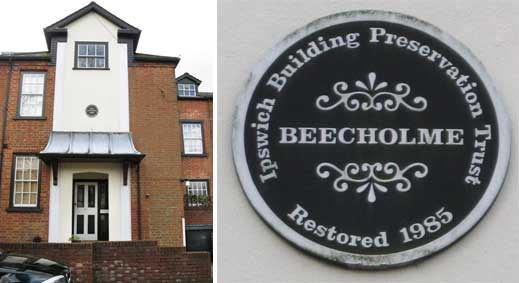
Beecholme, 129 Woodbridge Road
Another Ipswich Building Preservation Trust (see
Links) renovation of a sizeable
residential structure in a commanding position on the corner
with Lacey Street. They don't always mark their projects (see Trinity Lodge) and this particular
plaque is at the rear entrance to the building, off Lacey Street. See
also The Wrestlers, The Globe Inn, The
Half Moon & Star, Curson Lodge,
the nearby house at 1 Arthurs Terrace, also 163
Woodbridge Road.
Maritime Ipswich 1982 plaques
The Maritime Ipswich festival of 1982
marked the birth of The Ipswich Maritime Trust (see Links) and the beginning of a slow, gradual
remodelling of the Wet Dock
of
heavy industry and maltings of the Industrial Revolution. This
eventually culminated in the Waterfront
Regeneration Scheme. Ten plaques were cast by Crane Ltd. and
erected on notable buildings by The Ipswich Society. All are still in situ.
Site of Thomas Eldred's house, The Sailors Rest, Isaac Lord
merchant's house, The Captain's Houses, The Custom House, Old
Neptune Inn, Isaac's
(malt kiln), Henry
Tooley almshouses, The
Old Bull Inn, Henry
Palmer warehouses.
In 2017 The Ipswich Society (see Links)
has fully revised and republished the 1982 Ipswich Maritime Trail booklet
which now encompasses and identifies all ten oval plaques (shown above)
in a series of linked walks around the historic Wet Dock and
surrounding area.
Copies of the new Ipswich
Maritime Trail are available at the Ipswich
Tourist Information Centre at £2.00
each.
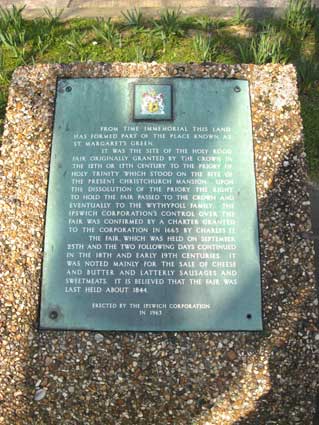
Thingstead
This plaque reads:
'FROM TIME IMMEMORIAL THIS LAND
HAS FORMED PART OF THE PLACE KNOWN AS
ST. MARGARET'S GREEN.
IT WAS THE SITE OF THE HOLY ROOD
FAIR ORIGINALLY GRANTED BY THE CROWN IN
THE 12TH OR 13TH CENTURY TO THE PRIORY OF
HOLY TRINITY WHICH STOOD ON THE SITE OF
THE PRESENT CHRISTCHURCH MANSION. UPON
THE DISSOLUTION OF THE PRIORY THE RIGHT
TO HOLD THE FAIR PASSED TO THE CROWN AND
EVENTUALLY TO THE WYTHYPOLL FAMILY. THE
IPSWICH CORPORATION'S CONTROL OVER THE
FAIR WAS CONFIRMED BY A CHARTER GRANTED
TO THE COPORATION IN 1665 BY CHARLES II.
THE FAIR, WHICH WAS HELD ON SEPTEMBER
25TH AND THE TWO FOLLOWING DAYS CONTINUED
IN THE 18TH AND EARLY 19TH CENTURIES. IT
WAS NOTED MAINLY FOR THE SALE OF CHEESE
AND BUTTER AND LATTERLY SAUSAGES AND
SWEETMEATS. IT IS BELIEVED THAT THE FAIR WAS
LAST HELD ABOUT 1844.
ERECTED BY THE IPSWICH CORPORATION
IN 1963'
St Margaret's Green isn't very green.
St Margaret's Plain isn't
much of a plain. However, the street of that name is certainly a
street. These areas put together were known from the times of King Cnut
until the 19th century, as Thingstead, which is Danish for a meeting
place. They stand just outside the northern ramparts and North Gate of
the town. The above plaque stands in front of the former public house
The Saracen's Head, a 16th to 17th century timber-framed structure,
closed in 1960 to become a motor works with drive-in petrol pumps and
in the 1970s and 80s a Comet
electrical eqipment store; it is now a business centre. The area of St
Margaret's Green was, from the time of Holy
Trinity Priory, a
very fashionable place which was overlooked in the 17th and 18th
centuries by the houses of the gentry (including that bearing the
Nathaniel Bacon blue plaque, see above). Indeed some of these large
houses stand today. It was the meeting place of the parishioners of the
old Wicklaw hundred and, as we read above, the site of an important
fair. Several taverns served travellers and fair-goers including The
Running
Buck, The Packhorse as well as The
Saracen's
Head were all nearby. In
the 1790s the Cobbold family lived on the Green, before the move in
1814 to their mansion in Holywells Park.
In their employ was a servant
called Margaret Catchpole who gained notoriety and almost mythical fame
as Suffolk's leading (anti-)heroine, who skirted the law on many an
occasion
and stole and rode her master's horse to London, all in the cause of
her
lawless lover.
Old Ipswich Society plaque
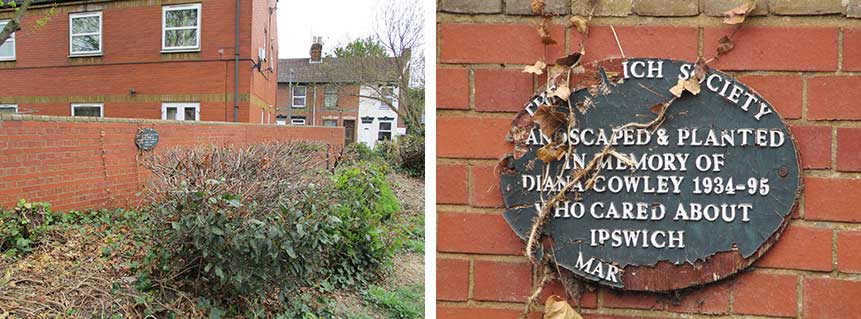 2022
image
2022
image
'THE IPSWICH SOCIETY
LANDSCAPED & PLANTED
IN MEMORY OF
DIANA COWLEY 1934-95
WHO CARED ABOUT
IPSWICH
MAR...'
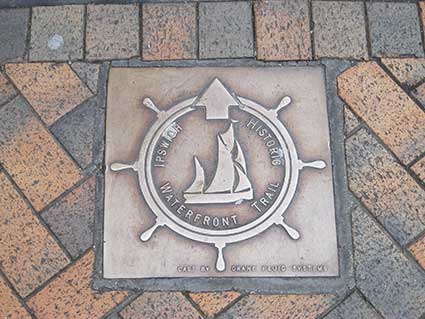 2016
image
2016
image
Historic Waterfront
Trail
'IPSWICH
HISTORIC WATERFRONT TRAIL
CAST BY CRANE FLUID SYSTEMS'
The sailing barge and ship's wheel cast in bronze by Crane Co. include a directional arrow indicating
the direction for walkers along the trail. This 'Historic Waterfront
Trail' differs from the Ipswich
Maritime Trail of 1982 (completely revised and republished by
The Ipswich Society in 2017). There are a number of these attractive,
pavement-level plaques in
the town. The above example is in Lower Brook Street. John Field,
formerly Principal Planning Officer (Civic Design) and Town Centre
Manager at the Borough, tells us that the Ipswich
Borough Council leaflet to accompany the bronze plaques trail was
published when the Church of St Stephen became the Tourist Information
Centre in 1994. "These plaques were produced by Cranes for the Borough
Council. Through my personal link with the Personnel Manager at
the company, they produced the plaques free of charge and I had a
couple of meetings with the apprentices who were used to produce the
plaques as part of their training."
'Twinned' with Arras
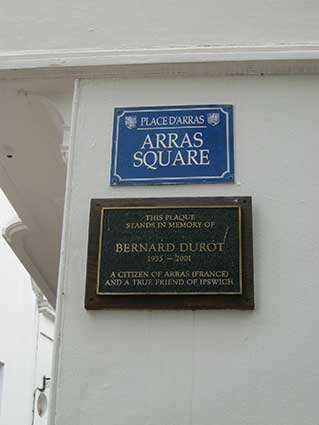 2016
image
2016
image
'PLACE D'ARRAS
ARRAS SQUARE'
'THIS PLAQUE
STANDS IN MEMORY OF
BERNARD DUROT
1935 ~ 2001
A CITIZEN OF ARRAS (FRANCE)
AND A TRUE FRIEND OF IPSWICH'
Much of Arras in northern France was devastated in World War I
but was
rebuilt to the original architects’ designs including the distinctive
gables which give the houses surrounding the Grand Place such
character. The town was also the scene of fierce fighting during World
War II. Ipswich and Arras were 'twinned' in 1993 (the fee for official
twinning under the government scheme was apparently a disincentive) and
the paved area
outside the new Buttermarket Shopping Centre was named Arras Square to
mark the relationship. The two plaques shown above are attached to the
south wall of The Ancient House, close
to St Stephens Lane.
John Field, formerly Principal Planning
Officer (Civic Design) and Town Centre Manager at the
Borough and
Chair of the Ipswich Arras Association***, tells us that: "Bernard
Durot referred to on the plaque was the first President of the Arras
Ipswich Association and the plaque was erected by the Council obviously
after his death, and we arranged for his wife and daughter to be
present at the unveiling with the Mayor and other people in attendance.
Bernard was an English teacher and Councillor in Arras; he was a great
anglophile and, as stated, friend of Ipswich. As Chairman of the
Ipswich Arras Association from the beginning it was a great pleasure to
work closely with Bernard on a number of projects over the years."
[***http://ipswicharrasassociation.onesuffolk.net]
See our page about the Ipswich coat of arms
for an equivalent street nameplate for Place d'Ipswich in Arras.
The Orwell Bridge
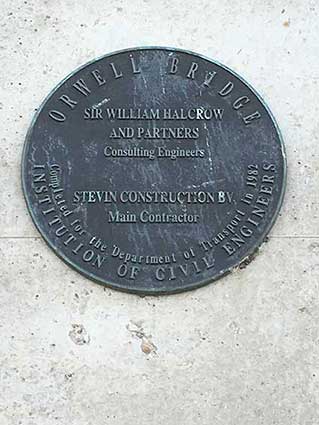 2017
image courtesy Tony Marsden
2017
image courtesy Tony Marsden
'ORWELL BRIDGE
SIR WILLIAM HALCROW
AND PARTNERS
Consulting Engineers
STEVIN CONSTRUCTION BV
Main Contractor
Completed for the Department of Transport in 1982
INSTITUTION OF CIVIL ENGINEERS'
This little-seen plaque is fixed
onto one of the main piers of the bridge on the Freston Strand side.
Our thanks to Tony Marsden for recording it – we'd been told about it
on a river trip on the Sailing Barge
Victor, but never got round to
visiting the site. The bridge carries the A14 (formerly the A45) trunk
road from
Felixstowe Docks to the A1, the M1 and the midlands. Since the
mushrooming of these docks the bridge carries many times the volume of,
in particular, heavy traffic than that at its opening.
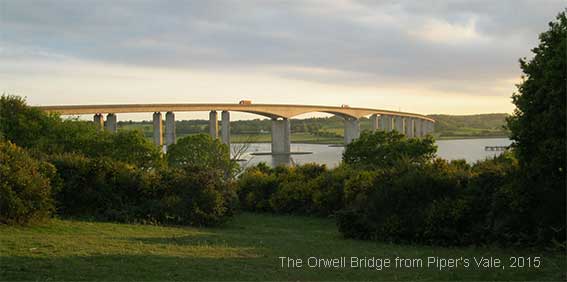 2015 image
2015 image
The main span of the Orwell Bridge is 190 metres which, at the time of
its construction (1982), was the longest pre-stressed concrete span in
use. The total length is 1,287 metres from the Wherstead side to
Piper’s Vale. The width is 24 metres with an air draft of 43 metres.
Pilings were sunk 40 metres into the river bottom. The main contractor
was Stevin Construction B.V., a Dutch company. The main span was
constructed by using a balanced cantilever technique, casting sections
on alternating sides of the pier in a weekly cycle. The bridge is
constructed of a pair of continuous concrete box girders with expansion
joints that allow for expansion and contraction. The girders are
hollow, allowing for easier inspection, as well as providing access for
services, including telecom, power and a 711mm water main from the
nearby Alton Water reservoir. The air draft of the central span was
chosen to be as low as possible without adversely affecting port
operations. The consulting engineers were Sir William Halcrow and
Partners. Frederick Gibberd Partners worked on the project to ensure
the bridge was as sympathetic as possible to the Orwell estuary, with
the final design winning the approval of the Royal Fine Art Commission.
The bridge was set at an angle to the river to get the best
relationship to the surrounding terrain.
Many, including The Ipswich Society, opposed the building of the bridge
in the late 1970s and early 1980s. However, its shape has become – that
overused term – 'iconic' and is repeatedly used by local companies and
organisations in
logos and namestyles. The bridge lies roughly halfway between the old Bourne Bridge and the Monkey Lodge to Woolverstone Hall, Freston.
See also our Willis
monolith page for the obelisk which marks 800 years of Ipswich
history. Hardly a plaque, as such, but it relates to this page.
See also our Lettered castings index page.
Home
Please email any comments and contributions by clicking here.
Search Ipswich
Historic Lettering
©2004 Copyright
throughout the Ipswich
Historic Lettering site: Borin Van Loon
No reproduction of text or images without express written permission

 2024 image
2024 image 2024
image
2024
image 2023
image courtesy Tim Leggett
2023
image courtesy Tim Leggett 2022
images
2022
images 2022
images
2022
images 2019
image
2019
image 2019
image
2019
image 2016
image
2016
image
 2017 image
2017 image 2016
images
2016
images

 January
2015
January
2015



 and next door:
and next door: 
 and under the arch:
and under the arch:





 2013 images
2013 images









 (replaced
an earlier cast iron plaque)
(replaced
an earlier cast iron plaque)  Library window
Library window
 2013 image
2013 image
 Plaque in St
Clements Church Lane.
Plaque in St
Clements Church Lane.
 2022
image
2022
image

 1845
1845

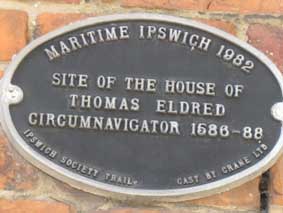
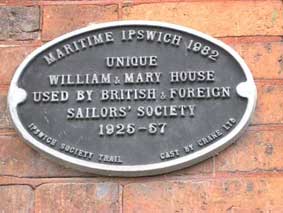
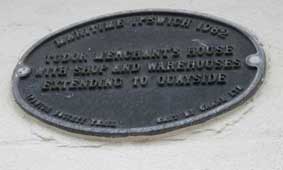
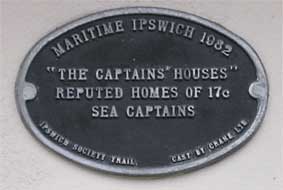
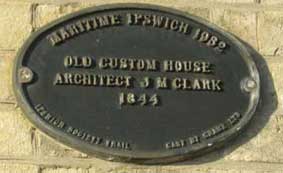
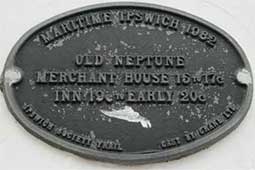
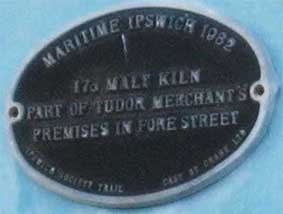
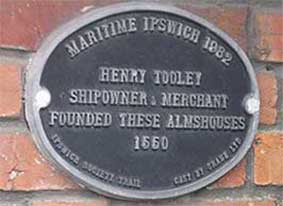
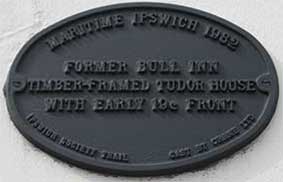
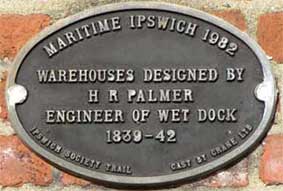

 2022
image
2022
image 2016
image
2016
image 2016
image
2016
image 2017
image courtesy Tony Marsden
2017
image courtesy Tony Marsden 2015 image
2015 image